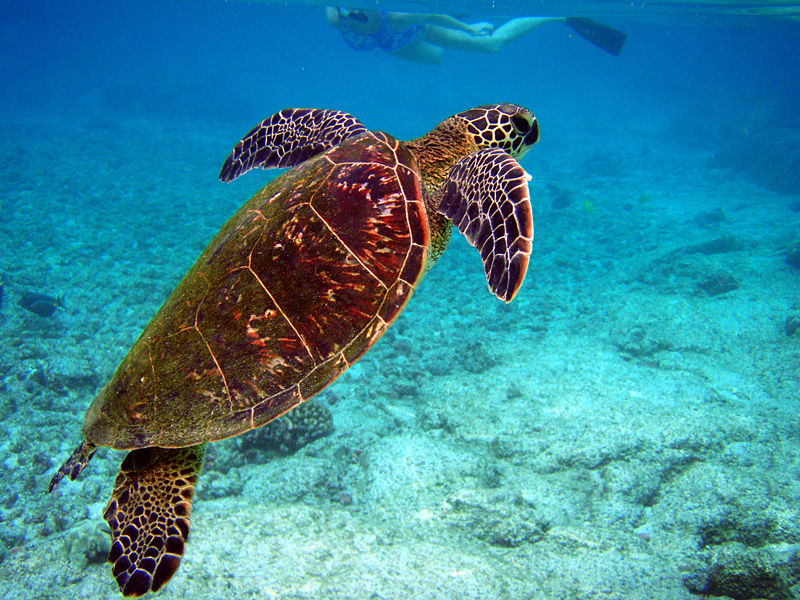If you've ever tried running along a beach on soft, dry sand, you'll how much hard work  it can be; the grains of sand shifting beneath your feet slow you down and make it more likely you will slip and fall over. Sea turtles know only too well the perils of sandy beaches. After they hatch, baby turtles emerge from their nests and run the gamut of the beach, down to the waves. Even though they only spend a few brief moments on land, baby turtles can move with remarkable speed across sand even if it is loose and slippery. The question is: how do they do it?It turns out that newborn turtles use their flippers to produce small blocks of compact sand, which act like a solid allowing the turtles to propel themselves rapidly across the beach surface. These findings are published in the journal Biology Letters by Daniel Goldman and colleagues from the Georgia Institute of Technology in the US.Last year, Goldman and his team built a creature called SandBot, a simple robotic creature that helped them understand how real animals cope with walking across soft sand. The researchers found they had to carefully adjust the movements and timing of Sandbot's six legs in order to get it to walk across rather than swim inefficiently through the sand.Turning their attention to turtles, the team went down to the beach at Jekyll Island, armed with a mobile laboratory to work with the Georgia Sea Turtle centre. Together they took high-speed film of hatchling leatherback turtles crawling along a trackway covered either with loosely packed sand or sand paper to mimic hard ground.The researchers were very careful not to disturb the turtles too much, only taking 5 animals from each nest, and only trying three runs for each animal before releasing them back onto the same spot they were taken from.It came as a surprise to see that the turtles dealt equally well with the solid surface or the loose sand, crawling along at similar speeds on both, but employing two different techniques. The turtles' flippers gripped into the sandpaper using a small claw. When they were on sand something else was going on: high speed film revealed that the flippers pushed into the sand at precisely the right angle and force to build up blocks of compacted sand which they then push against, generating thrust to move forwards.It goes to show how animals can evolve elegant biomechanical solutions for the physical problems that the natural world throws at them. To build a robot that can walk across sand requires intricate laboratory experiments. Meanwhile turtles have arrived - without having to think about it - at their own way of getting themselves from nest to sea, and back again, a mode of transport that scientists are just beginning to understand.
it can be; the grains of sand shifting beneath your feet slow you down and make it more likely you will slip and fall over. Sea turtles know only too well the perils of sandy beaches. After they hatch, baby turtles emerge from their nests and run the gamut of the beach, down to the waves. Even though they only spend a few brief moments on land, baby turtles can move with remarkable speed across sand even if it is loose and slippery. The question is: how do they do it?It turns out that newborn turtles use their flippers to produce small blocks of compact sand, which act like a solid allowing the turtles to propel themselves rapidly across the beach surface. These findings are published in the journal Biology Letters by Daniel Goldman and colleagues from the Georgia Institute of Technology in the US.Last year, Goldman and his team built a creature called SandBot, a simple robotic creature that helped them understand how real animals cope with walking across soft sand. The researchers found they had to carefully adjust the movements and timing of Sandbot's six legs in order to get it to walk across rather than swim inefficiently through the sand.Turning their attention to turtles, the team went down to the beach at Jekyll Island, armed with a mobile laboratory to work with the Georgia Sea Turtle centre. Together they took high-speed film of hatchling leatherback turtles crawling along a trackway covered either with loosely packed sand or sand paper to mimic hard ground.The researchers were very careful not to disturb the turtles too much, only taking 5 animals from each nest, and only trying three runs for each animal before releasing them back onto the same spot they were taken from.It came as a surprise to see that the turtles dealt equally well with the solid surface or the loose sand, crawling along at similar speeds on both, but employing two different techniques. The turtles' flippers gripped into the sandpaper using a small claw. When they were on sand something else was going on: high speed film revealed that the flippers pushed into the sand at precisely the right angle and force to build up blocks of compacted sand which they then push against, generating thrust to move forwards.It goes to show how animals can evolve elegant biomechanical solutions for the physical problems that the natural world throws at them. To build a robot that can walk across sand requires intricate laboratory experiments. Meanwhile turtles have arrived - without having to think about it - at their own way of getting themselves from nest to sea, and back again, a mode of transport that scientists are just beginning to understand.










Comments
Add a comment